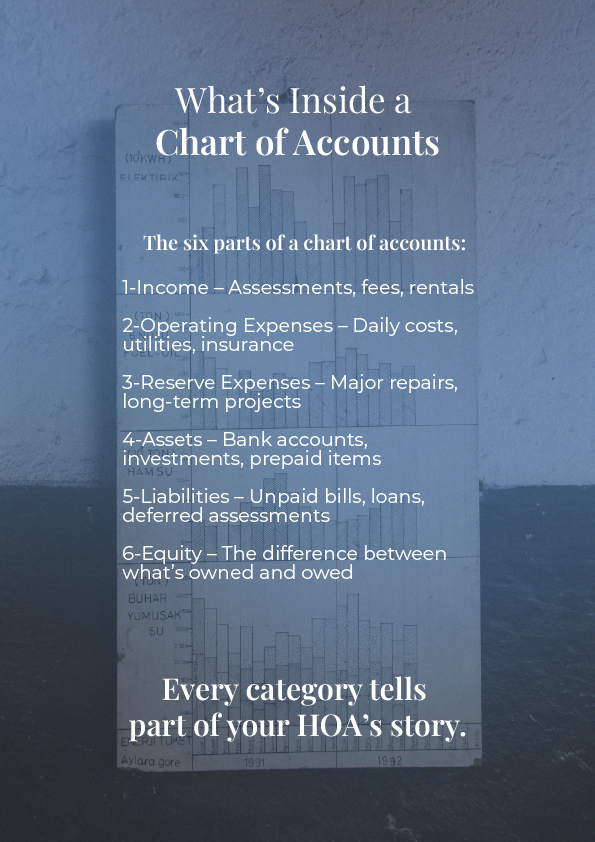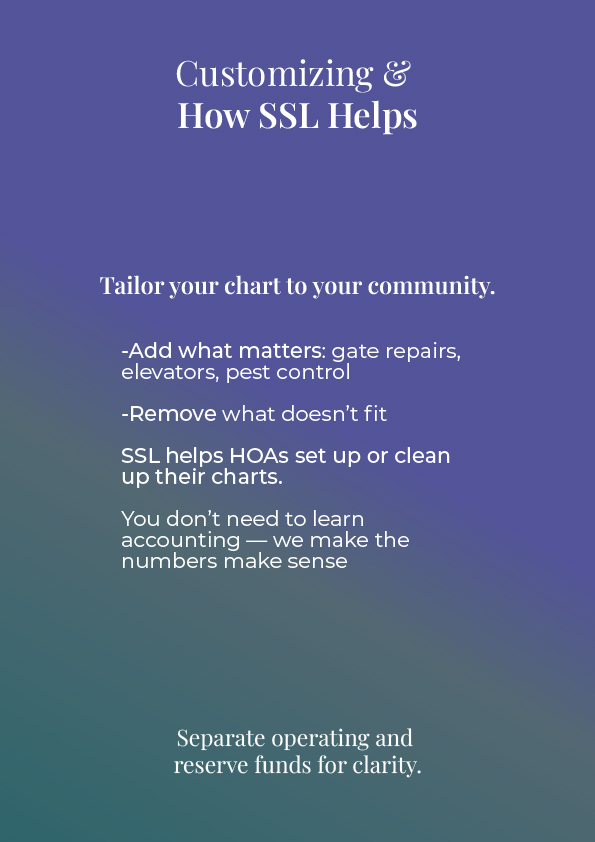The board sat in silence while the treasurer clicked through her laptop. Numbers scrolled across the screen. No labels, no categories, no clear structure. Just lines of transactions that meant nothing to anyone in the room.
Someone asked if the HOA was over budget. Another wanted to know where the landscaping payment had gone. Nobody could say for sure. The account balance looked healthy, but they couldn’t track where the money came from or where it was going. A few old checks hadn’t even been cashed yet.
They’d been doing their best, but it was a mess. No system. No structure. No chart of accounts. The reports were useless, and every meeting turned into a guessing game. That night, they agreed to bring in help. The first question their advisor asked was simple: “Can I see your chart of accounts?”
Table of Contents
What Is a Chart of Accounts?
A chart of accounts is a simple list. It shows every category your HOA uses to track money. It shows money coming in and money going out. It also tracks what you own and what you owe.
Think of it as a quick guide to your money. It shows you where to look when you need info. With a clear setup, anyone can open the books and follow the flow. You see money coming in. You see money going out. You see what stays in the bank.
Without it, things get messy fast. One payment ends up under repairs, another under landscaping, and the next under “misc.” You waste time guessing. Board meetings run long. Budgets fall apart.
The chart brings order. It lets your treasurer work faster. It makes audits cleaner. And it gives your board the one thing every HOA needs: clarity.
What’s Inside a Chart of Accounts
A chart of accounts splits your HOA’s money into clear buckets. Each bucket shows a different part of the picture.

a. Income
This covers all the money that comes in. Most of it comes from assessments. You may see late fees or fines here. Rental income can show up too. Someone may even pay to use the clubhouse for a party.
b. Operating Expenses
This is the day-to-day spending. You’ll see regular costs like landscaping and water. Trash pickup and power sit here too. Insurance and cleaning fall in this group as well. Anything that keeps things running lands here.
c. Reserve Expenses
This section covers major repairs or future projects. Think roof replacements, repaving, or a new security gate. These are not regular bills. They are big jobs you plan and save for ahead of time.
d. Assets
Assets are what the HOA owns. This includes your checking and savings accounts, long-term reserves, and anything prepaid like insurance or service contracts.
e. Liabilities
Liabilities are what you owe. This includes unpaid bills, outstanding loans, and deferred assessments. If the HOA has promised to pay something but hasn’t yet, it lands here.
f. Equity
Equity shows your net position. It’s the difference between what the HOA owns and what it owes. This section shows if you’re in the black or in financial trouble.
How a Good Chart Prevents Problems
Here’s an analogy. You’ve got two toolboxes. One has every tool in the right place. The other is a jumble of loose screws and mystery parts. One saves time. The other causes headaches.
That’s what it’s like running an HOA without a clear chart of accounts. Reports take too long to read. Budgeting turns into guesswork. Mistakes go unnoticed. The board starts doubting the numbers, and each other.
A clean chart keeps everything where it belongs.
What It Looks Like in Practice
In a meeting, the treasurer opens the report and reads straight from the page. “We spent $4,200 this quarter on landscaping. That’s Account 6100. We budgeted $4,500, so we’re under.”
No blank stares. No confusion. Each line tells the board what happened and how it lines up with the plan.
“Account 1305 is our reserve fund. We’re at $110,000. That covers the roof replacement planned for 2026.”
The chart breaks things into simple categories. Operating income. Maintenance costs. Utilities. Reserve contributions. Everything has a number and a home.
When someone asks about the pool heater or the legal bill, there’s a clear answer. The board can focus on decisions, not detective work.
Setting One Up: Who Does It and How?
Most HOAs ask an accountant or a management company to build their chart of accounts. They know how to group the numbers in a way that makes sense. The board still needs to understand the structure because they rely on it at every meeting.
Software can help. QuickBooks and HOA platforms like AppFolio or Buildium offer templates. They do not replace the setup work. Someone must decide which accounts to use and what goes where.
Once it exists, someone must keep it tidy. New expenses show up. Projects begin and end. A chart of accounts works best when someone reviews it often and adjusts it before confusion starts.
Customizing Your HOA’s Chart

Every HOA runs a little differently. Your chart of accounts should match how your board actually spends money.
A gated neighborhood might need a line for “Gate Repairs.” A high-rise condo may include “Elevator Maintenance.” Some communities might track storm cleanup, parking enforcement, or pest control.
It’s easy to copy someone else’s chart, but that rarely works. If a category doesn’t reflect real spending, drop it. If you need one that’s missing, create it. The chart only works when it reflects your community.
How SSL Can Help
We help HOAs set up or clean up their chart of accounts so board members can read reports without confusion.
You don’t need to learn accounting. We handle the categories and fix any gaps. The layout stays simple. You get quick answers and better choices.
We make the numbers make sense. That’s it.


